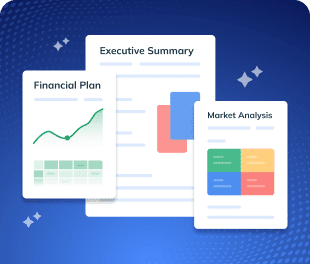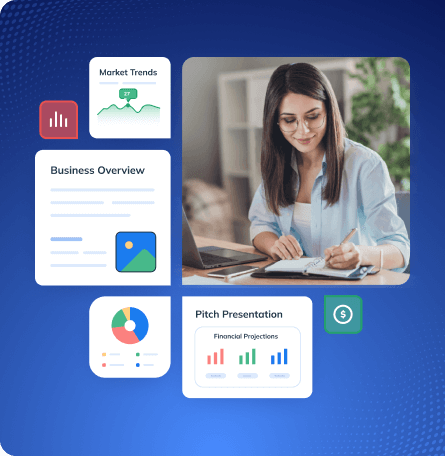Running a grocery store sounds simple—after all, everyone needs food. But turning that everyday demand into a business that actually works? Takes planning.
Whether you’re starting small, like a corner shop, or going bigger with a full-sized supermarket, it all comes down to one thing: A clear, workable plan.
Not sure where to start?
This grocery store business plan will walk you through everything from your executive summary to financial projections.
How to Write a Grocery Store Business Plan?
Writing a grocery store business plan is a crucial step toward the success of your business. Here are the key steps to consider when writing a business plan:
1. Executive Summary
The executive summary gives a quick snapshot of your entire grocery store business plan. This section helps readers like investors, lenders, or partners understand your vision, how the store will run, and why it’s worth their time or support.
Even though this section sits right at the very front of your plan, here’s a tip: it’s best to tackle this part last. That way, you’ve got all your facts straight from the rest of the plan, letting you keep the summary to the point.
Here’s what to include in your executive summary:
- Grocery store concept & location
- Business model (retail sales, delivery, subscriptions, or other services)
- Target market (local families, working professionals, students)
- Unique selling points (USPs)
- Marketing strategy
- Financial highlights (revenue goals)
- Funding needs (If any)
- Appendix (optional)
Ultimately, this whole section should feel upbeat, realistic, and inspiring enough to genuinely make the reader eager to flip through the rest of your detailed plan.
Say goodbye to boring templates
Build your business plan faster and easier with AI
Plans starting from $14/month

2. Business Overview
This business overview section explains what your grocery store is all about, your concept, structure, location, and what you’re building. It’s a snapshot of your store’s identity.
Here’s what to include in your business overview:
| Section | What to Include |
|---|---|
| Store name & concept | Name + type of store (local, organic, ethnic, etc.) |
| Legal structure | Chosen structure (LLC, sole prop, etc.) + quick reason |
| Location | Planned location + why it works (foot traffic, demand) |
| Ownership & team | Owner(s) + roles or strengths of key people |
| Mission & vision | What your store stands for and your long-term goal |
| Goals & milestones | Immediate launch goals + future plans (e.g., expansion) |
By the end of this section, readers should’ve a clear sense of what kind of store you’re building, why it makes sense for your area (location of operation), and who’s behind it.
3. Market Analysis
The market analysis provides a clear understanding of the market in which your small grocery store business will run, along with your target market, competitors, and growth opportunities.
Your market analysis should contain the following essential components:
Target market
Identify your target market and define your ideal customer. This can include age, economic level, family size, purchasing interests, and nutritional preferences.
Here’s an example of your core customer:
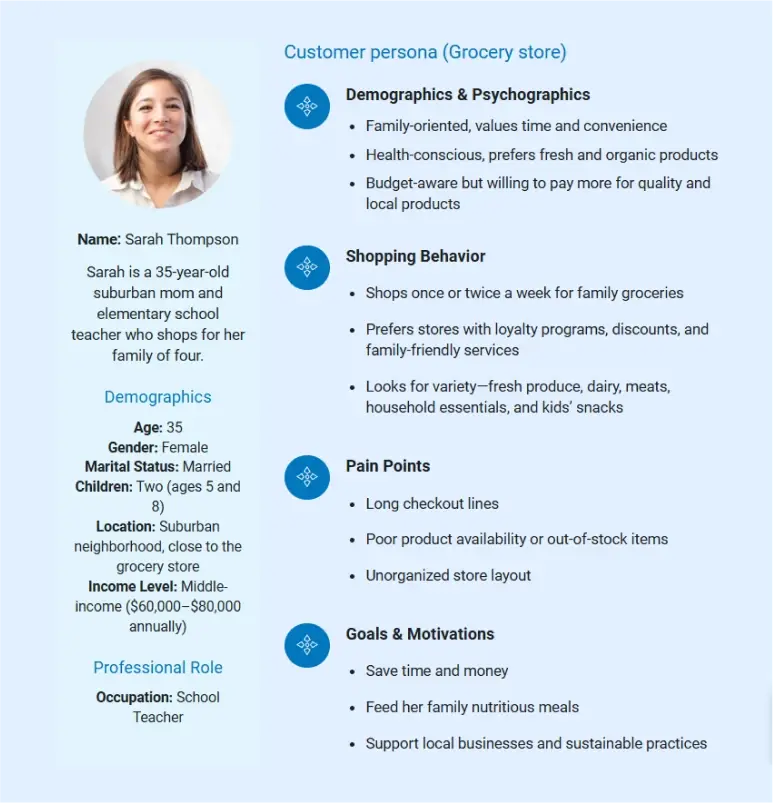
Market size and trends
Use local or national data to show the opportunity:
- Annual grocery spending in your area
- Growth in specialty segments like organic, international, or health-focused foods
- Increased demand for contactless checkout, in-app ordering, or home delivery
Show how your store will tap into these trends with the right mix of inventory and services.
Competitor analysis
Start by looking at two or three grocery stores in your area. Maybe one has a great variety and strong branding but charges higher prices, while another is more affordable but has poor customer service or an outdated layout.
Think about where they fall short and how your store can do better. Maybe in terms of faster checkout, a cleaner layout, or friendlier service. Show how your store fills the gaps and offers something shoppers aren’t getting elsewhere.
Market opportunity
End this section by connecting the dots:
- There’s steady demand
- There’s a clear customer base
- There are gaps you can fill
- And your store is positioned to meet those needs directly
The key is to clearly define your target customers. Once that’s done, the rest of this section comes together much easily.
4. Products and Services
The heart of any grocery store lies in what it sells. Your store should aim to offer everyday items people need, while also being known for quality and convenience.
You can carry a wide variety of goods, including:
| Category | Examples |
|---|---|
| Fresh Produce | Fruits, vegetables, herbs |
| Dairy Products | Milk, cheese, butter, yogurt |
| Meat & Poultry | Chicken, mutton, eggs, fish |
| Grains & Staples | Rice, wheat, pulses, flour |
| Packaged Snacks & Sweets | Biscuits, chips, chocolates, candies |
| Frozen & Ready-to-Eat | Frozen meals, snacks, frozen vegetables |
| Cooking Essentials | Spices, oil, salt, sauces, condiments |
| Beverages | Soft drinks, juices, bottled water, tea, coffee |
| Household Essentials | Detergents, soaps, toothpaste, cleaning supplies |
| Optional Services | Home delivery, seasonal kits, bulk orders, loyalty rewards, local tie-ups |
Quality and freshness should be a top priority. Ensure all perishable items are stored correctly and checked regularly. Having a reliable supply chain will also help keep shelves stocked without compromising on standards.
This section gives a clear picture of what customers can expect from your store.
5. Sales and Marketing Strategies
Setting up your grocery store is just one part of the process; getting customers through the door (and keeping them coming back) is just as important. That’s where a strong sales and marketing strategy comes in.
Here’s how you can approach it:
What makes us special? (unique hook)
You might focus on locally grown produce, stock hard-to-find international items, or offer great everyday value. Whatever it is, you need to make it clear and consistently remind customers why they should choose you over the next shop.
Smart pricing that works for everyone
People shop smart, especially when it comes to groceries. Your pricing needs to be competitive, but still leave room for profits. Occasional offers, loyalty discounts, or “buy more, save more” deals can help draw attention and drive bigger purchases.
Spreading the word locally
Getting the news out doesn’t have to break the bank. Just a few quick updates on social media about fresh arrivals or weekend deals can surprisingly bring a good amount of foot traffic.
Old-school flyers, eye-catching in-store posters, and even simple referral programs (think “bring a friend, get a discount!”) are super effective, low-cost ways to market. Don’t forget to optimize your Google My Business profile – it’s important for locals trying to find you online.
Bringing people in and back
Promotions tied to festivals, free tasting sessions, or weekend family offers can pull in new faces. But the real win is making them return. Great service, clean displays, fast checkouts, and the occasional “we remembered your favorite brand” moment go a long way.
At the end of the day, your strategy is about connection, making people feel that your store is part of their routine, not just a random stop.
6. Operations Plan
When writing the operations plan section, it’s important to consider the various aspects of your business processes and procedures involved in operating a business.
Here are the components to include in an operations plan:
Hiring plan
Start by outlining your staffing needs. How many employees will you need to manage checkout counters, stock inventory, handle deliveries, or manage the floor? Be clear about their roles and what skills or experience you’re looking for.
Also, include any employee perks or benefits you’ll offer to help attract and retain good talent.
Daily operations
Explain how your grocery store will function on a regular day. That includes how you’ll place and receive product orders, manage stock levels, restock shelves, handle customer service, and keep the store clean and organized.
If you’re offering delivery or online ordering, mention how that process will work too.
Technology and equipment
To run your grocery store efficiently, you can rely on a few essential tools:
- A Point-of-Sale (POS) system for quick checkouts and sales tracking.
- Barcode scanners to speed things up and keep inventory accurate.
- Inventory management software to track everything from stock levels to reorders.
- Reliable refrigeration units and freezers for all our fresh and frozen items.
- Strong security systems to keep everyone safe and prevent theft.
Having these essential tools and clear daily routines means you’re setting up a business that’s ready to operate effectively every single day.
7. Management Team
The management team section provides an overview of the individuals responsible for running the grocery store.
Include the following in your plan:
- Ownership and leadership: Who owns the business, and what relevant experience or background do they bring to the business?
- Key team members: Highlight essential roles like Store manager, Procurement lead, Floor supervisor, Finance or Admin manager, and Delivery coordinator, if applicable.
- Experience and qualifications: Summarize each person’s relevant background that makes them a good fit for their role.
- Compensation and structure: Mention how the team is compensated, such as salary, bonuses, or equity, if relevant.
- Advisory support: If any external consultants, mentors, or advisors are involved, note their names and contributions.
Try adding a simple chart to show how roles are structured and who reports to whom. Here’s a sample layout you can adapt for your plan:
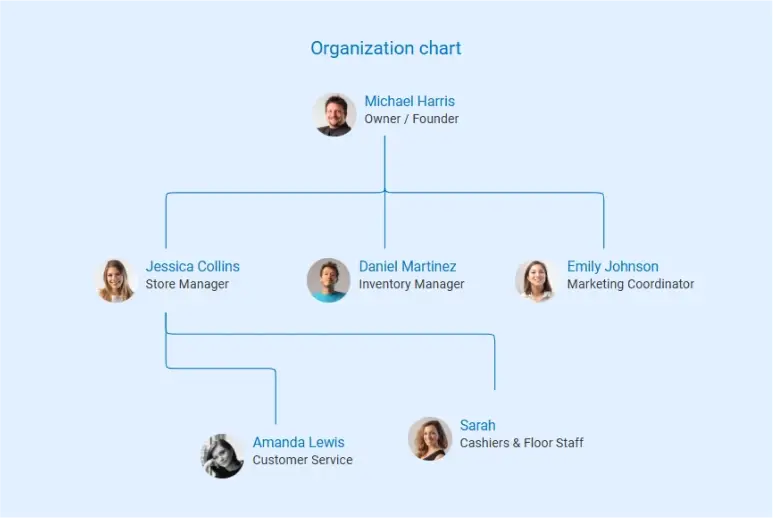
With an experienced team and clear roles, our grocery store is set up for smooth operations and steady growth. This strong management foundation will help us serve customers well and achieve our goals.
8. Financial Plan
Your financial plan lays out the money side of your grocery store business. It’s where you show exactly how you’ll bring in revenue, manage all your costs, and ultimately make a profit.
Key financial statements
Below are the key statements your financial plan should include:
| Statement Name | Description | Includes |
|---|---|---|
| Profit & Loss Statement | Projects the store’s income and expenses over time, showing profitability. | Revenue, Cost of Goods Sold (COGS), Operating Expenses, Net Profit or Loss. |
| Cash Flow Statement | Tracks the movement of cash in and out of the business to ensure liquidity. | Cash receipts from sales, vendor payments, loan repayments, other inflows/outflows. |
| Balance Sheet | Provides a snapshot of the store’s financial position at a given point in time. | Assets (current & fixed), Liabilities (short & long-term), Owner’s Equity. |
| Break-even Analysis | Identifies the point at which revenue covers all operating costs. | Fixed Costs, Variable Costs, Contribution Margin, Break-even Revenue/Units. |
If you’re seeking funding, clearly state it. Break down how the funds will be used, such as for inventory, marketing, branding, or working capital.
For more clarity, you can add a chart showing the use of startup funds. Sort of like this:
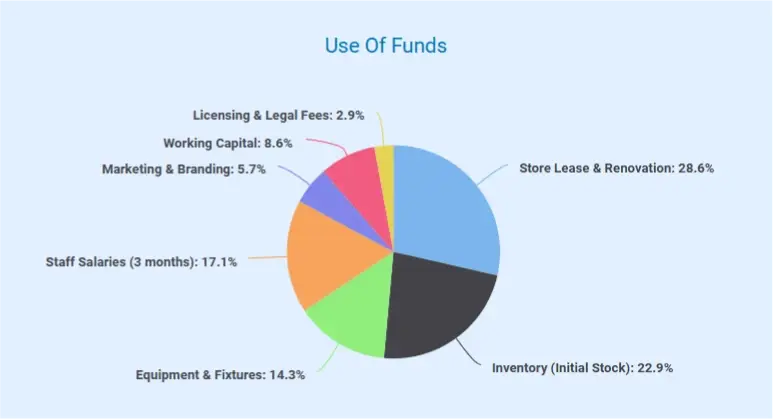
This section should show that your numbers are grounded and assumptions are realistic, and your store will become financially sustainable with time.
9. Appendix
The appendix section includes extra documents and data that support your business plan. While not required for every reader, it’s helpful for lenders, investors, or partners who want to see proof behind your assumptions.
You can include:
- Financial statement backups (detailed cash flow projections, P&L reports)
- Market research data or survey results
- Supplier agreements or sample invoices
- Lease agreement or property photos
- Business registration or licenses
- Menu of products or categories (with pricing)
- Equipment quotes
- Staff training manuals or onboarding outline
- Charts or visuals referenced in your financial plan (e.g., break-even graph, funding allocation pie chart)
Use a table of contents within the appendix if your appendix is longer than a few pages, and keep everything clearly labeled so it’s easy to refer to.
Download a free grocery store business plan template
Ready to start putting your grocery store plan together, but want a little help with formatting? No problem. Download our free grocery store business plan template (PDF) to get started.
It’s a pre-formatted and ready-to-use template. It covers everything from the executive summary to financial projections. All you have to do is, just fill in the details that fit your specific store, make a few adjustments, and you’ll have a solid, professional plan in no time.
The Quickest Way to turn a Business Idea into a Business Plan
Fill-in-the-blanks and automatic financials make it easy.
Summary
Now that you’ve gone through this step-by-step guide and have a template as a handy tool, so might be in a much better position to draft your grocery business plan.
But, feeling stuck? Upmetrics can help. Our business planning software makes the entire process easier with smart AI suggestions, clean formatting, and built-in tools for financial forecasting, competitor analysis, and more.
So why wait? Start planning smarter, right now!
